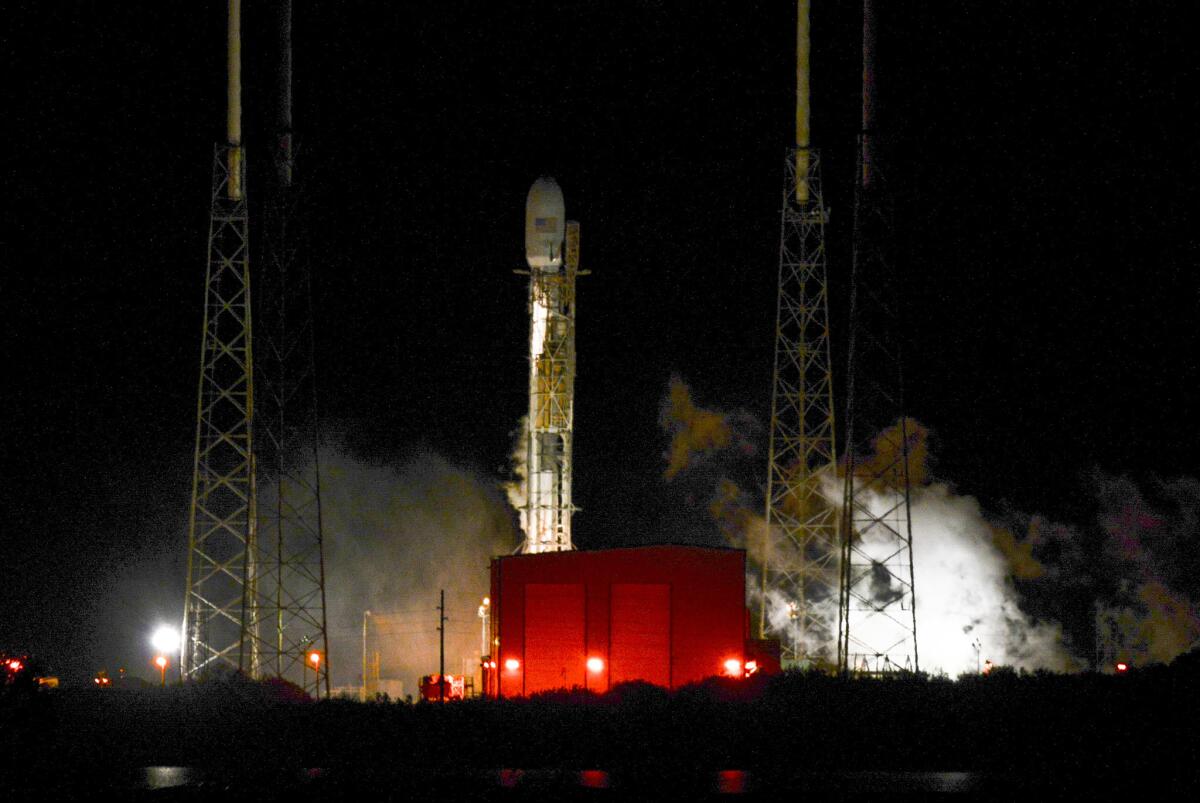SpaceX launches satellite into orbit; booster landing at sea fails

A SpaceX Falcon 9 rocket remains on the launch pad Sunday at Cape Canaveral Air Force Station.
- Share via
After several scrubbed launches and delays in the last week and a half, SpaceX successfully blasted a commercial communications satellite into orbit Friday, but its rocket experienced a “hard landing” on a drone ship in the ocean.
Liftoff occurred at 3:35 p.m. Pacific time at Cape Canaveral Air Force Station in Florida.
About three minutes after the launch, the first and second stages of the Falcon 9 rocket separated, with the second stage carrying the satellite into orbit.
About 32 minutes after liftoff, the satellite deployed, pushing away from the second stage of the rocket as employees at SpaceX’s Hawthorne headquarters cheered.
At 4:30 p.m., company Chief Executive Elon Musk said the satellite’s target altitude of 40,600 kilometers was achieved.
The satellite, SES-9, is to provide services such as broadcasting and video capabilities, maritime connectivity and high-speed broadband for more than 20 countries in the Asia-Pacific region. It is owned by Luxembourg-based satellite operator SES.
The first-stage booster was attempting a soft landing on a drone ship called Of Course I Still Love You, positioned in the Atlantic Ocean about 400 miles east of Cape Canaveral. Such a landing would allow the booster to be reused -- a key component of SpaceX’s approach to save money and launch frequently.
About eight minutes after liftoff, the video feed from the barge lost signal. About an hour and a half after the initial launch, Musk tweeted that the rocket “landed hard on the droneship.”
“Didn’t expect this one to work,” he tweeted. “But the next flight has a good chance.”
SpaceX had said before the launch that it was not expecting a successful landing on the barge this time. The rocket used a lot of fuel to push the satellite into a high orbit near the equator, and the booster also faced the additional challenge of turning itself around and correcting its course to land on the drone ship.
This was SpaceX’s fifth attempt to launch the rocket since Feb. 24.
Three of the scrubs were attributed to fuel-related issues. The most recent delay came Tuesday when SpaceXt chose to push the launch to Friday because of “extreme high altitude wind shear,” according to a tweet from Musk.
SpaceX, whose full name is Space Exploration Technologies Corp., had one successful first-stage ground landing in December, but it has now failed four times to nail a landing at sea.
For more business news, follow @smasunaga.
MORE ON SPACEX
SpaceX scrubs rocket launch just moments before liftoff
SpaceX’s hyperloop student contest brings out many big benefactors
SpaceX rocket failure cost NASA $110 million
More to Read
Inside the business of entertainment
The Wide Shot brings you news, analysis and insights on everything from streaming wars to production — and what it all means for the future.
You may occasionally receive promotional content from the Los Angeles Times.











